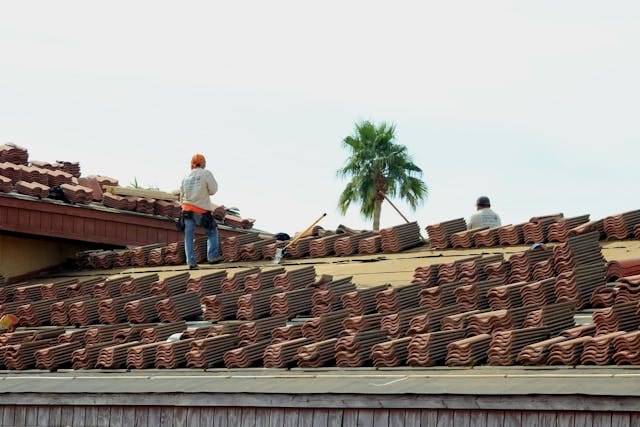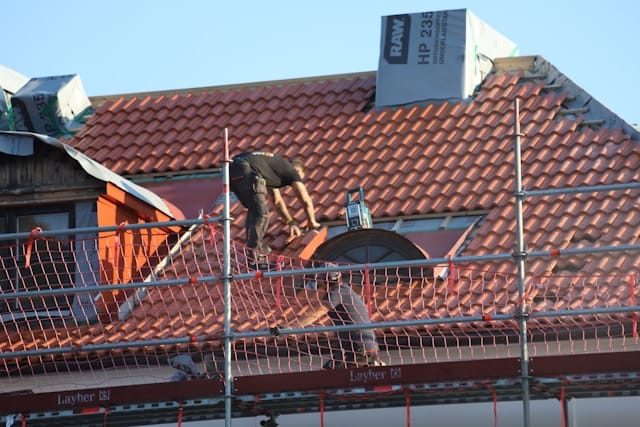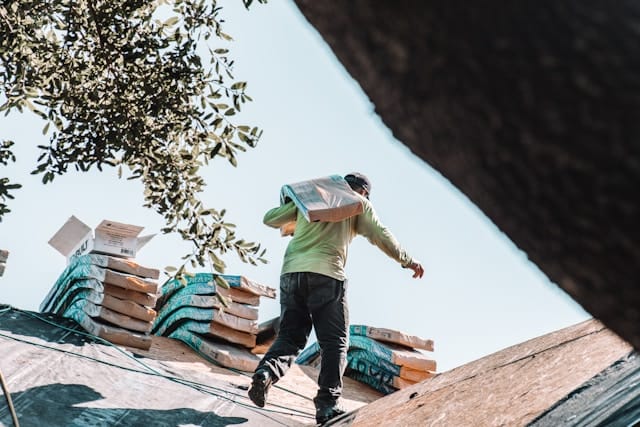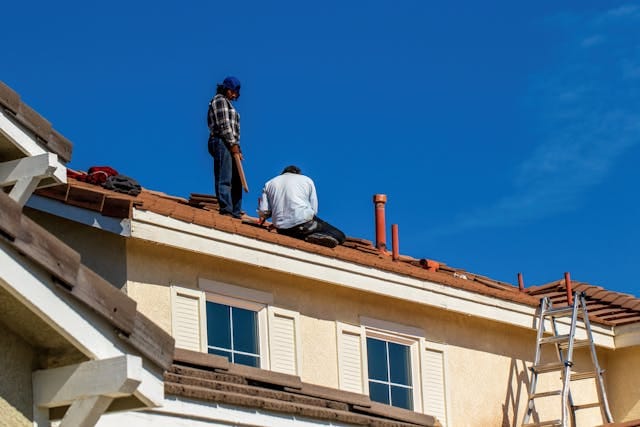
6 Signs Your Business Needs Roof Replacement and How to Find the Right Service
A well-maintained roof is essential for the safety, efficiency, and longevity of any commercial property. Over time, exposure to harsh weather, aging materials, and ongoing wear and tear can lead to significant damage. Ignoring early warning signs can result in costly repairs, structural issues, and even business disruptions. Recognizing when a roof replacement is necessary can help prevent further damage and protect both employees and customers.
Here are six key signs that indicate it’s time to replace your commercial roof and how to find the right service for the job.
Table of Contents
Key Takeaways
✔ Persistent leaks and water stains indicate underlying damage that simple repairs cannot fix.
✔ Sagging, cracks, or missing roofing materials signal structural weakness that may lead to further deterioration.
✔ Rising energy bills often result from poor insulation caused by a failing roof.
✔ If the roof has exceeded its expected lifespan, replacement is a more cost-effective long-term solution.
✔ Repeated repairs can quickly become more expensive than investing in a full roof replacement.
✔ An unstable roof poses serious safety risks to employees, customers, and business operations.✔ Choosing the right roofing service involves researching licensed contractors, checking reviews, comparing estimates, and ensuring compliance with local regulations.

6 Signs Your Business Requires Roof Replacement Now
1. Frequent Leaks and Water Damage
A commercial roof should provide strong protection against the elements. However, persistent leaks and water damage can indicate that a roof replacement is necessary. Even minor leaks, if left unaddressed, can lead to significant structural issues and costly repairs.
Signs of Persistent Leaks Despite Repairs
Leaks that continue even after multiple repairs often signal deeper roofing problems. If a business is experiencing repeated water infiltration, it may be time to consider commercial roof replacement rather than temporary fixes.
- Recurring Water Intrusion: Water leaks in the same spots, even after repairs, suggest underlying damage that patchwork solutions cannot resolve.
- Ceiling Stains: Brown or yellow stains on ceilings and walls indicate prolonged water exposure, which can weaken the building’s structure over time.
- Peeling Paint or Wallpaper: Moisture from leaks can cause paint or wallpaper to bubble, peel, or discolor, affecting the building’s interior appearance and air quality.
Water Stains and Mold Growth Inside the Building
Water damage does not always appear as visible leaks. In many cases, it manifests as stains or mold growth, which can create health risks and further damage the property. If signs of internal moisture issues persist, a roof replacement near me search may help find local experts to assess the damage.
- Mold or Mildew Odor: A musty smell inside the building often indicates hidden moisture and mold growth, which can compromise indoor air quality. Persistent water intrusion from a damaged roof can lead to mold growth, which may trigger asthma attacks in individuals allergic to mold.
- Discolored Ceiling Tiles: Dark or damp patches on ceiling tiles suggest water is seeping through the roof, potentially leading to structural decay.
- Warped Flooring or Walls: Prolonged exposure to moisture can cause wooden floors to warp and drywall to soften, requiring expensive repairs.
2. Visible Structural Damage
A business’s roof plays a vital role in protecting the property, employees, and customers. Over time, wear and tear can lead to visible structural damage, which is a strong indication that a roof replacement may be necessary.
Sagging, Cracks, or Missing Shingles
Structural issues such as sagging, cracks, or missing shingles can weaken the integrity of the roof. These problems often develop due to age, weather conditions, or poor installation.
- Sagging Areas: A sagging roof indicates that the underlying support structure is compromised, possibly due to water damage or excessive weight from debris accumulation. This can lead to a total roof collapse if not addressed promptly.
- Cracks in the Roofing Surface: Cracks often appear in roofing materials due to expansion and contraction from temperature changes. They allow moisture to seep in, leading to mold growth, wood rot, and insulation damage.
- Missing or Loose Shingles: High winds, heavy rain, and general wear can cause shingles to detach. Missing shingles expose the roof to direct sunlight and moisture, accelerating deterioration and increasing roof replacement cost in the long run.
Warped or Deteriorating Roofing Materials
Roofing materials degrade over time, especially in areas with extreme weather conditions. Warped or deteriorating materials are clear signs that commercial roof replacement may be necessary.
- Buckling or Curling Shingles: When shingles begin to lift or curl, it means they are no longer providing proper protection. This can lead to leaks, heat loss, and increased energy costs.
- Waterlogged or Rotting Wood: Wooden components of a roof can absorb moisture, leading to rot and mold growth. This weakens the structure and poses a significant safety risk.
- Rust or Corrosion on Metal Roofs: For metal roofing systems, rust or corrosion can indicate that the protective coating has worn off. Over time, this can cause holes or weak spots, necessitating roof replacement near me services.

3. Increased Energy Bills
A business’s energy costs can rise significantly due to a failing roof. Poor insulation and structural damage allow heat to escape during winter and excess heat to enter during summer. As a result, heating and cooling systems must work harder, leading to higher utility bills.
Role of Insulation in Energy Efficiency
Proper insulation is essential for maintaining a stable indoor temperature. A damaged or aging roof can compromise insulation, making it difficult to regulate heat and cooling.
- Heat Loss in Winter: Cracks, gaps, and deteriorating materials allow warm air to escape, forcing heating systems to work harder.
- Heat Retention in Summer: A compromised roof lets excessive heat in, making air conditioning systems run longer and consume more energy.
- Uneven Temperature Distribution: Poor insulation can lead to hot and cold spots inside the building, creating discomfort for employees and customers.
Signs That a Roof is Causing Higher Energy Costs
It is important to recognize the warning signs of roofing problems that affect energy efficiency.
- Unexplained Increase in Utility Bills: If energy costs rise without a change in usage, heat loss or gain from the roof may be the cause.
- Drafts or Temperature Fluctuations: A noticeable difference in temperature between rooms suggests insulation failure.
- Ice Dams or Excessive Heat Build-Up: In colder climates, ice dams may form due to poor insulation, while warmer climates may experience excessive heat absorption.
Understanding Roof Replacement Costs and Long-Term Savings
While the roof replacement cost may seem like a significant investment, it can lead to substantial energy savings.
- Reduced HVAC Usage: A well-insulated roof provides resistance to heat flow, reducing the strain on heating and cooling systems. This lowers energy costs while also improving indoor comfort, creating a more efficient and temperature-regulated environment.
- Longer Lifespan: High-quality roofing materials require less maintenance and last longer.
- Incentives and Rebates: Some energy-efficient roofing systems may qualify for government or utility company incentives.
4. Aging Roof
A commercial roof is built to last, but over time, natural wear and tear can compromise its integrity. Business owners should pay attention to the condition of their roofing system, as an aging roof can lead to costly repairs, energy inefficiencies, and safety hazards.
Exceeding Its Expected Lifespan
Every roof has a set lifespan based on its materials, installation quality, and exposure to environmental factors. If a roof is approaching or has surpassed its expected durability, it may be time for a roof replacement.
- Material Lifespan Matters: Different roofing materials have varying lifespans. For instance, flat roofs typically last 20–25 years, while metal roofing can endure up to 50 years with proper maintenance.
- Frequent Repairs Are a Warning Sign: If a business is constantly dealing with leaks, patchwork, or maintenance calls, it could indicate that the roof has outlived its usefulness.
- Manufacturer’s Warranty Expiration: Many commercial roofing systems come with warranties that cover a specific period. If the warranty has expired, the risk of out-of-pocket repair costs increases.
Deterioration Due to Weather Exposure
Over time, commercial roofs are exposed to harsh weather conditions, which accelerate deterioration. This makes it crucial for business owners to assess damage caused by natural elements.
- UV Damage Weakens Materials: Constant sun exposure can cause roofing materials to dry out, crack, or blister, leading to structural weaknesses.
- Heavy Rain and Snow Cause Wear: Prolonged exposure to moisture can result in water pooling, leaks, and mold growth, all of which require immediate attention.
- Wind Damage Can Displace Roofing Components: Strong winds may lift or tear roofing membranes, leaving the structure vulnerable to further damage.
Temperature Fluctuations Lead to Expansion and Contraction: Roofing materials expand in heat and contract in cold conditions. Over time, this repeated movement causes cracks and weak points that can lead to leaks.
5. Frequent Repairs
A commercial roof plays a critical role in protecting a business’s property, employees, and operations. However, when repairs become too frequent, they may no longer be cost-effective.
Hidden Costs of Frequent Repairs
Ongoing roof repairs may seem like a temporary fix, but they can lead to higher expenses over time. When a roof consistently needs attention, it may indicate underlying issues that simple patchwork cannot resolve.
- Escalating Repair Bills: The cost of multiple small repairs can quickly add up, often exceeding the price of a new commercial roof replacement over time.
- Recurring Water Damage: Leaks and moisture intrusion can cause mold growth and interior damage, requiring costly repairs beyond just the roof itself.
- Energy Inefficiency: A failing roof may lead to poor insulation, increasing heating and cooling costs. Checking roof replacement costs can help determine if upgrading is more economical.

6. Safety Concerns
A structurally stable roof is essential for the safety of a business’s employees, customers, and overall operations. When a roof begins to show signs of instability, it can create hazardous conditions that may lead to injuries, property damage, and even legal liabilities.
Risks of Delaying Roof Replacement
Ignoring roof issues can lead to serious injuries, putting employees, customers, and visitors at risk. Structural instability increases the chances of accidents, making timely commercial roof replacement essential for safety.
- Falling Debris and Roof Collapse: A deteriorating roof can shed materials or collapse, leading to severe injuries for those inside or near the building. Businesses may be held liable for negligence if injuries occur.
- Slip-and-Fall Hazards: Leaks and water damage can create slippery surfaces, increasing the likelihood of slips and falls that could result in serious harm.
- Weakened Structural Integrity: A roof that is no longer stable can cause sections of the building to weaken, leading to potential accidents from falling ceilings or broken infrastructure.
- Electrical Hazards: Water leaks from a failing roof can reach wiring and electrical systems, increasing the risk of short circuits, shocks, or even fires.
How to Find the Right Roof Replacement Service
Choosing the right roofing service in Southbury, CT, is essential for ensuring a durable and high-quality roof replacement. With many roof replacement contractors available, it is important to evaluate options carefully to avoid costly mistakes. A well-installed roof can protect a business for years, making it crucial to work with qualified professionals who use high-quality materials and follow proper industry standards.
1. Research and Compare Contractors
Finding the right roof replacement contractors starts with thorough research. Business owners should look for companies with a strong reputation, extensive experience, and a history of successful projects. A reliable contractor should be licensed and insured, which protects both the business and the workers handling the installation. Insurance coverage ensures liability protection in case of accidents or property damage during the roofing process.
2. Check Reviews and References
Customer feedback is an excellent way to assess the credibility of a roofing contractor. Business owners should read online reviews and request references from past clients to gain insight into the contractor’s reliability, quality of work, and professionalism. Additionally, inspecting past projects—whether through photos or in person—can help determine if the company’s work meets expectations.
3. Ask About Materials and Techniques
The longevity of a roof depends on the quality of materials and installation methods used. When discussing a commercial roof replacement, business owners should inquire about the materials available, such as metal, asphalt, or flat roofing systems. A reputable contractor will recommend the best materials for the building’s structure and climate conditions, ensuring long-term durability and energy efficiency.
4. Request Detailed Estimates
Understanding roof replacement cost is essential before committing to a service. Business owners should request detailed written estimates from multiple roof replacement contractors to compare pricing, warranties, and included services. A transparent estimate should outline labor costs, materials, timeline, and any additional fees.
5. Verify Compliance with Local Regulations
Roofing projects must comply with local zoning laws and building codes to avoid fines or legal issues. A professional contractor should be knowledgeable about these regulations and ensure that the roof meets all safety and structural requirements. Searching for “roof replacement near me” can help business owners find roof replacement contractors familiar with the specific codes in their area.
Frequently Asked Questions
How long does a roof replacement take?
The time needed for a roof replacement depends on the size of the house and the type of roofing material used. In most cases, it takes between one to three days to complete the work. Weather conditions and unexpected repairs can sometimes extend the timeline. A roofing contractor can provide a more accurate estimate based on the specific project.
Will I have to close my business during roof replacement?
In most cases, businesses can continue operating while the roof is being replaced. However, there may be some disruptions due to noise, dust, and construction activity. If the work requires closing certain areas for safety reasons, the contractor will inform the business owner in advance. Planning with the roofing company can help minimize any impact on daily operations.
Does insurance cover commercial roof replacement?
Insurance may cover a commercial roof replacement if the damage is caused by an event like a storm, fire, or vandalism. However, if the roof is simply old or has not been properly maintained, the cost of replacement is usually not covered. It’s important to check with the insurance provider to understand what is included in the policy. In some cases, a roofing contractor can help with the insurance claims process.
What are the common reasons for commercial roof failure?
Common reasons for commercial roof failure include poor installation, lack of maintenance, severe weather damage, and old age. Water pooling, cracks, and structural issues can also lead to major problems over time. Ignoring minor damages can make the roof wear out faster. Regular inspections and timely repairs help prevent unexpected failures.
How often should a commercial roof be replaced?
The lifespan of a commercial roof depends on the material used, maintenance, and environmental factors. Some roofs last 20-30 years, while others may need replacement sooner if they face harsh weather or poor upkeep. Regular inspections can help identify issues before they become serious. When a roof reaches the end of its expected lifespan, it’s time to start planning for replacement.
Get Reliable Roof Replacement in Southbury, CT, Today!
When it comes to protecting your business, a strong and durable roof is essential. Roofing Contractor of Southbury offers expert roof replacement services in Southbury, CT, ensuring high-quality materials, professional installation, and long-term protection. Don’t let an aging or damaged roof put your property at risk—trust our experienced team for reliable solutions.
Contact Roofing Contractor of Southbury today for a comprehensive assessment and expert roofing services in Southbury, CT!
